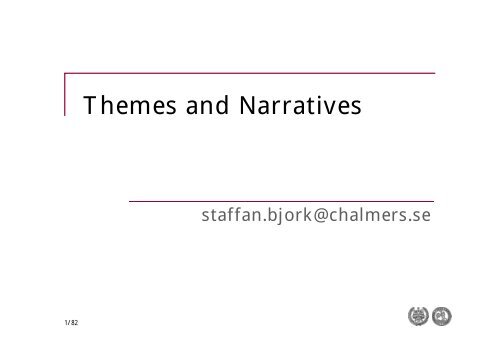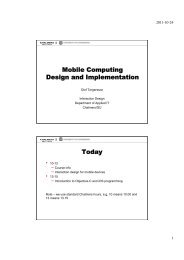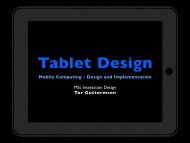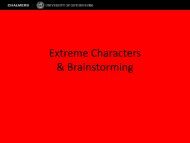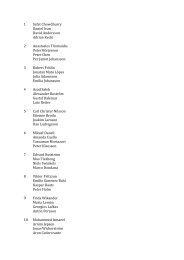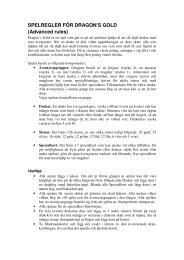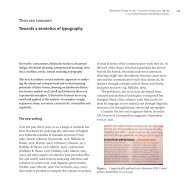Lecture 9 - Interaction Design & Technologies
Lecture 9 - Interaction Design & Technologies
Lecture 9 - Interaction Design & Technologies
You also want an ePaper? Increase the reach of your titles
YUMPU automatically turns print PDFs into web optimized ePapers that Google loves.
Themes and Narratives<br />
staffan.bjork@chalmers.se<br />
se<br />
1/82
Structure of the lecture<br />
• What are narratives<br />
• A closer look at plots and plot structures<br />
• An alternative view from game developers<br />
• <strong>Design</strong> Documents<br />
2/82
But first a game or two…<br />
Two volunteers<br />
Not usual suspects!<br />
3/82
First to 15<br />
• Two players taking turn<br />
• Each turn a choice ce from the following:<br />
o 1 2 3 4 5 6 7 8 9<br />
• Goal to reach exactly 15 points<br />
• You win iff three of your numbers add up to<br />
15<br />
• Cannot take a number already taken<br />
• By either player<br />
• This is not first to 12…<br />
4/82
Tic-Tac-Toe<br />
5/82
6/82<br />
Now both! At the same time!
Magic Square<br />
Not magic circle…<br />
2 7 6<br />
9 5 1<br />
4 3 8<br />
4 9 2<br />
3 5 7<br />
8 1 6<br />
7/82
37 78 29 70 21 62 13 54 5<br />
6 38 79 30 71 22 63 14 16<br />
47 7 39 80 31 72 23 55 15<br />
16 48 8 40 81 32 64 24 56<br />
57 17 49 9 41 73 33 65 25<br />
26 58 18 50 1 42 74 34 66<br />
67 27 59 10 51 2 43 75 35<br />
36 68 19 60 11 52 3 44 76<br />
77 28 69 20 61 12 53 4 45<br />
Would this make a good game<br />
8/82
Difference between theme and<br />
narrative<br />
• Theme<br />
• Mood<br />
• Context<br />
• How to “read” affordances<br />
• Explain relations in system<br />
• Which “frame” to use<br />
• Narrative<br />
• Temporal development<br />
• Causal effects<br />
• Dramatic effects<br />
• Can you have theme without narrative<br />
• Can you have narrative without theme<br />
9/82
What connection does narratives<br />
& gameplay have<br />
10/82
Structures of Narratives<br />
• First analysis<br />
• Tragedy<br />
• Poetics, Aristotle, 300<br />
BC<br />
• Components<br />
• Plot<br />
• Character<br />
• Reasoning<br />
• Dictation<br />
ti<br />
• Lyric poetry<br />
• Spectacle<br />
11/82
Frazer<br />
• The Golden Bough<br />
• Different version from<br />
1890-1922<br />
1922<br />
• Study of the origins of<br />
magic and religion<br />
• Similar stories all over<br />
the world<br />
• Sacrificial killing of<br />
god-kings to ensure<br />
bountiful harvests<br />
• Adonis<br />
• Osiris<br />
• Balder<br />
12/82
Propp, 1928<br />
• Morphology of<br />
Russian folk<br />
stories<br />
• Studied stories<br />
• Identified<br />
similarities<br />
• Identified<br />
common<br />
structure<br />
• Grammar<br />
• Linear structure<br />
• 1. A member of a family leaves home (the hero<br />
is introduced);<br />
d)<br />
• 2. An interdiction is addressed to the hero<br />
('don't go there', 'go to this place');<br />
• 3. The interdiction is violated (villain enters the<br />
tale);<br />
• 4. The villain makes an attempt at<br />
reconnaissance (either villain tries to find the<br />
children/jewels etc; or intended victim<br />
questions the villain);<br />
• 5. The villain gains information about the victim;<br />
• 6. The villain attempts to deceive the victim to<br />
take possession of victim or victim's belongings<br />
(trickery; villain disguised, tries to win<br />
confidence of victim);<br />
• 7. Victim taken in by deception, unwittingly<br />
helping the enemy;<br />
• 8. Villain causes harm/injury to family member<br />
(by abduction, theft of magical agent, spoiling<br />
crops, plunders in other forms, causes a<br />
disappearance, expels someone, casts spell on<br />
someone, substitutes child etc, commits murder,<br />
imprisons/detains someone, threatens forced<br />
marriage, provides nightly torments);<br />
Alternatively, a member of family lacks<br />
something or desires something (magical potion<br />
etc);<br />
13/82
Propp, cont.<br />
• 9. Misfortune or lack is made known, (hero is<br />
• Examples<br />
• Hans and Gretel<br />
• Snow White<br />
• Other cases<br />
• Odysseus<br />
• Moses<br />
dispatched, hears call for help etc/ alternative is<br />
that victimized hero is sent away, freed from<br />
imprisonment);<br />
• 10. Seeker agrees to, or decides upon counter-<br />
action;<br />
• 11. Hero leaves home;<br />
• 12. Hero is tested, interrogated, attacked etc,<br />
preparing the way for his/her receiving magical<br />
agent or helper (donor);<br />
• 13. Hero reacts to actions of future donor<br />
(withstands/fails the test, frees captive,<br />
reconciles disputants, performs service, uses<br />
adversary's powers against them);<br />
• 14. Hero acquires use of a magical agent<br />
(directly transferred, located, purchased,<br />
prepared, spontaneously appears, eaten/drunk,<br />
help offered by other characters);<br />
• 15. Hero is transferred, delivered or led to<br />
whereabouts of an object of the search;<br />
• 16. Hero and villain join in direct combat;<br />
• 17. Hero is branded (wounded/marked, receives<br />
ring or scarf);<br />
• 18. Villain is defeated (killed in combat,<br />
defeated in contest, killed while asleep,<br />
banished);<br />
14/82
Propp, cont.<br />
• Grammar<br />
constructed by<br />
analysis<br />
• Can be used to<br />
create stories<br />
• Fairytale generator<br />
• http://www.brown<br />
.edu/Courses/FR0<br />
/FR0<br />
133/Fairytale_Gen<br />
erator/gen.html<br />
• But create games<br />
• 19. Initial misfortune or lack is resolved<br />
(object of search distributed, spell broken,<br />
slain person revived, captive freed);<br />
• 20. Hero returns;<br />
• 21. Hero is pursued (pursuer tries to kill, eat,<br />
undermine the hero);<br />
• 22. Hero is rescued from pursuit (obstacles<br />
delay pursuer, hero hides or is hidden, hero<br />
transforms unrecognizably, hero saved from<br />
attempt on his/her life);<br />
• 23. Hero unrecognized, arrives home or in<br />
another country;<br />
• 24. False hero presents unfounded claims; 25.<br />
Difficult task proposed to the hero (trial by<br />
ordeal, riddles, test of strength/endurance,<br />
other tasks);<br />
• 26. Task is resolved;<br />
• 27. Hero is recognized (by mark, brand, or<br />
thing given to him/her);<br />
• 28. False hero or villain is exposed;<br />
• 29. Hero is given a new appearance (is made<br />
whole, handsome, new garments etc);<br />
• 30. Villain is punished;<br />
• 31. Hero marries and ascends the throne (is<br />
rewarded/promoted).<br />
15/82
Campbell<br />
• The hero with a<br />
thousand faces, 1968<br />
• Monomyth<br />
• All myths have the<br />
same basic structure<br />
• Classical examples<br />
• Osiris<br />
i<br />
• Odysseus<br />
16/82
Campbell, cont.<br />
• Grammar<br />
constructed by<br />
analysis<br />
• Can be used to create<br />
stories<br />
• For example, Star Wars<br />
Why can one find<br />
these structures t in<br />
so many stories<br />
17/82
Narratives - Recap<br />
• Components<br />
• Plot<br />
• Character<br />
• Reasoning<br />
• Grammar<br />
• Sequence of actions<br />
• Prerequisites for<br />
actions<br />
• Options of actions<br />
18/82
19/82<br />
A closer focus on plots
Types of Plots<br />
• Possible worlds, Artificial Intelligence, and<br />
Narrative Theory, Ryan 2001<br />
• Sequential narrativity<br />
• “The king died. The queen died.”<br />
• Causal narrativity<br />
• “The king died, then the queen died.”<br />
• Dramatic narrativity<br />
• “The king died, then the queen died of sorrow.”<br />
20/82
Plots<br />
• Linear stories<br />
• One situation<br />
• One event leads to new<br />
situation<br />
• Does not have to be<br />
chronological order<br />
• Examples<br />
• Most books<br />
• Most movies<br />
21/82
Plots - a classical plot example<br />
• Scene 1<br />
• Introduction of<br />
problem<br />
• Scene 2<br />
• False solution<br />
• Scene 3<br />
• True solution<br />
22/82
Plots<br />
• Nested stories<br />
• Stories being told in<br />
stories<br />
• Easy change characters<br />
and setting<br />
• Examples<br />
• “One Thousand and<br />
One Nights”<br />
• Scheherazade<br />
• Canterbury tales<br />
23/82
Plots<br />
• Parallel stories<br />
• Several situation<br />
• Event leads to<br />
development in one<br />
situation<br />
• Does not have to be<br />
chronological order<br />
• Examples<br />
• Soap operas<br />
• …<br />
24/82
Plots<br />
• Branching stories<br />
• One situation<br />
• Several options of<br />
event that lead to<br />
different situations<br />
• Narrative explosion<br />
• Dead ends<br />
• Examples<br />
• Lonewolf<br />
25/82
Plots<br />
• Hypertexts<br />
• Events can lead back to<br />
previous situations<br />
• Break temporal<br />
structure<br />
• Examples<br />
• Talmud<br />
• Absalom, Absalom!, ,<br />
Faulkner<br />
• Memento<br />
26/82
Plots - Other variants<br />
• Possibilities<br />
• Not predetermined<br />
• Let players choose<br />
situations and events<br />
• Only plan certain<br />
situations and events<br />
• prerequisites need<br />
27/82
What type of plot structures<br />
28/82
Motivations for telling stories<br />
• Tell Me a Story – Narrative and Intelligence, Shank 1990<br />
• AI perspective<br />
• Me goals<br />
• Attention<br />
• Explain actions<br />
• Get advice<br />
• You goals<br />
• Give people an experience<br />
• Make a point<br />
• Transfer information<br />
• Conversation goals<br />
• Raise topic<br />
• Change subject<br />
• Spend time<br />
• Give response<br />
29/82
30/82<br />
Narratives and gameplay
What is the relation between<br />
games and narratives<br />
• Do all games have story<br />
narratives<br />
gameplay<br />
31/82
What is the relation between<br />
games and narratives, cont.<br />
• Do all stories have<br />
gameplay in them<br />
• <strong>Interaction</strong><br />
game<br />
play<br />
story<br />
32/82
Sliding story-gameplay y model<br />
Story-focused<br />
Gameplay-focused<br />
33/82
Story-focused games<br />
• Player choices<br />
• Complete task to<br />
progress in story<br />
• Puzzle<br />
• Level<br />
• Choose options from<br />
grammar<br />
• Related design areas<br />
• Interactive Narratives<br />
• Façade by Michael<br />
Mateas & Andrew Stern<br />
• Interactive Movies<br />
• Stories Movies<br />
34/82
Example: The Walking Dead<br />
35/82
Gameplay-focused games<br />
• Story use<br />
• Give theme<br />
• Provide information<br />
i<br />
• Provide immersion<br />
• Allow players to be<br />
creative<br />
• Related designs<br />
• Improvisational Theatre<br />
• Theatre Sports<br />
• Tarot Cards<br />
• Story-telling<br />
36/82
Scaling author model<br />
Game designer<br />
as author<br />
Roleplaying games<br />
Game engine as author<br />
Players as<br />
authors<br />
Put another way: who creates the story, the designer or the player<br />
37/82
Reductionistic Approach<br />
• What aspects of<br />
narrativity can be<br />
used without limiting<br />
gameplay<br />
• Theme | Premise<br />
• Characters<br />
• Challenge<br />
• Play<br />
• Cutscenes<br />
38/82
Reductionistic Approach<br />
• Theme<br />
• Aristotle’s spectacle<br />
• Used to create<br />
metaphor that gives<br />
actions meaning<br />
• Backstory<br />
39/82
Reductionistic Approach<br />
• Characters<br />
• Self-expression<br />
• Who one wants to be<br />
• Life on the Screen: Identity in<br />
the Age of the Internet, Sherry<br />
Turkle<br />
• External presentation<br />
• Internal composition<br />
• Possibility of Development<br />
• Emotional Anchor<br />
• But maybe not the characters<br />
under player’s control<br />
40/82
Reductionistic Approach<br />
• Challenge<br />
• Aristotle’s reasoning<br />
• Czikszentmihalyi’s s flow<br />
Difficulty<br />
• Activity requiring skill<br />
• Merging of action and<br />
awareness<br />
• Clear goals and feedback<br />
Frustration<br />
• Concentration on task Flow<br />
• Paradox of control<br />
• Loss of self-<br />
consciousness<br />
• Transformation of time<br />
• Activity becomes its own<br />
purpose - autotelic<br />
Boredom<br />
Skill<br />
41/82
Some professional views on<br />
stories in games<br />
42/82
Margaret Robertson@GDC2009<br />
• Things players actually care about (in<br />
descending order):<br />
• Where I am<br />
• What I can do<br />
• What I look like<br />
• Who I am<br />
• Note that she doesn’t mention back story<br />
or motivations…<br />
43/82
Margaret Robertson@GDC2009<br />
• Small Stories<br />
• Evoking emotions<br />
• Evoking interest<br />
• Not telling everything<br />
• Can carry theme and back story<br />
• Can provide traces of diegetic intentionality<br />
44/82
45/82
46/82
Margaret Robertson@GDC2009<br />
• A classic example<br />
• Ernest Hemingway<br />
• Six word challenge<br />
47/82
Margaret Robertson@GDC2009<br />
For sale: baby b shoes, never worn<br />
48/82
Margaret Robertson@GDC2009<br />
• Small stories, where can they be told<br />
• Set-up<br />
• Externally<br />
• Subtextually<br />
t • Environment<br />
• Gameplay<br />
• Exposition<br />
49/82
50/82
Margaret Robertson@GDC2009<br />
• Types of medium<br />
• HUD<br />
• Art<br />
• Animation<br />
• Sound<br />
• Text<br />
• Voice-over<br />
• Video<br />
• Types of Art<br />
• Clothes<br />
• Posters<br />
• Graffiti<br />
• Architecture<br />
• Weather<br />
• Signs<br />
51/82
52/82
53/82
54/82
55/82
56/82
57/82
Ken Rolston@GDC2009<br />
• Perspective: MMOGs & blunder management<br />
• Be vast<br />
• Modular<br />
• Extensible<br />
• Aims<br />
• Focus on moment to moment gameplay, not art<br />
• Avoid a Narrative with a Defined Protagonist<br />
• Lose lots of protagonists to meet<br />
• Lose possibilities to customize character<br />
• Sprinkle loose threads and narrative hooks<br />
58/82
Ken Rolston@GDC2009<br />
• Factions a feasible possible component<br />
• Start before narrative<br />
• Paper-Rock-Scissors structures can work well<br />
• Make main quests less important<br />
• Most important story: I’m not dead yet”<br />
• Ending main quest = killing your character<br />
• Main quest can lead players to different parts<br />
of fthe game<br />
59/82
60/82<br />
<strong>Design</strong> Documents
<strong>Design</strong> Documents -<br />
Motivation<br />
• Communicate overall vision i of game<br />
and gameplay<br />
• Ergo the game designer the primary<br />
author<br />
• Necessary for collaboration and<br />
coordination in larger groups<br />
• Can serves purposes in small (1 person)<br />
design teams also<br />
• Not substitute t for other forms of<br />
communication<br />
• Support for more detailed descriptions<br />
• Support for when people are not present<br />
61/82
Historical<br />
• <strong>Design</strong> documents were<br />
not used in early days of<br />
game design<br />
• Need not perceived<br />
• Compare to the history of<br />
craft and design in general<br />
• Complexity<br />
• Need for collaboration<br />
62/82
Format of <strong>Design</strong> Documents<br />
• Text document<br />
• Word (or rtf) for ease of transport<br />
• Version control –central source<br />
• Possibly sub-documents for extra details<br />
• Website<br />
• For example Wikis<br />
• Allows easy update for many<br />
• Allows difficulty in controlling who updates<br />
what<br />
• May be difficult to print, transport, etc.<br />
63/82
A model for <strong>Design</strong><br />
Documents<br />
That is, a model for the<br />
assignment 3…<br />
64/82
<strong>Design</strong> Document – <strong>Design</strong><br />
History<br />
• Description<br />
• Version number – overall idea of document state<br />
• Description of changes since last update<br />
• Motivation<br />
• Allow people to see differences<br />
quickly<br />
• Allow people to see how work<br />
has progressed over time<br />
• Both what type and<br />
scope of work<br />
65/82
<strong>Design</strong> Document – Vision<br />
Statement<br />
• Description<br />
• 1-2 pages that captures the essence of the game in<br />
a compelling and accurate way<br />
• Theme<br />
• Core gameplay (what you do 90% of the time)<br />
• Motivation<br />
• Executive summary<br />
• Main selling point<br />
• Keep design vision clear<br />
66/82
<strong>Design</strong> Document – Marketing<br />
Information<br />
• Description<br />
• Describe the context for the game<br />
design in aspects of target<br />
audience, platform, system<br />
requirements, top performers,<br />
feature comparison and sales<br />
expectations<br />
• Motivation<br />
<br />
<br />
<br />
Let distributors understand how well you have planned<br />
target audience and understood the market<br />
Explicitly state intended game play and target audience to<br />
the design team<br />
Can be seen as limiting the design space, identifying<br />
already existing games within that design space and their<br />
popularity<br />
67/82
<strong>Design</strong> Document – Legal<br />
Analysis<br />
• Description<br />
• Agreements regarding copyrights, trademarks,<br />
contracts, and licensing<br />
• Motivation<br />
• Make clear to all parties what obligations exist<br />
• Make clear how potential issues can be avoided or<br />
mitigated<br />
68/82
<strong>Design</strong> Document - Gameplay<br />
• Description<br />
• Core gameplay (preferably through prototype),<br />
detailed gameplay, interfaces, rules, scoring/win<br />
conditions, modes of play, levels, editors and tools<br />
• Motivation<br />
• Describe gameplay to external parties<br />
• Have complete description of what rules have to be<br />
implemented, what levels should be created, what<br />
interfaces should be designed<br />
69/82
<strong>Design</strong> Document - Characters<br />
• Description<br />
• General characteristics and functionality,<br />
PCs, NPCs, gameplay role, narrative role, AI<br />
• Motivation<br />
• Provide common location of description<br />
of characters to maintain character<br />
integrity during the design process<br />
70/82
<strong>Design</strong> Document - Story<br />
• Description<br />
• Synopsis and general structure,<br />
complete story, backstory,<br />
narrative devices, subplots<br />
• Motivation<br />
• Provide holistic view of what narrative experience<br />
• the player will have by playing the game<br />
• Making sure that contingency is<br />
maintained during gameplay<br />
71/82
<strong>Design</strong> Document – The Game<br />
World<br />
• Description<br />
• More details on the theme<br />
• Overview, key locations, travel, mapping,<br />
scale, ,physical objects, weather conditions,<br />
day and night, time, physics, society/culture<br />
• Motivation<br />
• Common location to describe functionality<br />
and appearance of the world and objects in it<br />
72/82
<strong>Design</strong> Document – Media List<br />
• Description<br />
• Interface assets, environments, characters,<br />
animations, music and sound effects (, text)<br />
• The appearance of what is described in the previous<br />
sections: Characters, Story, Game World<br />
• Motivation<br />
• Identify what artists and UI engineers need to create<br />
• Create uniform naming convention<br />
• to allow early implementations to use mock-ups<br />
• Avoid confusion<br />
73/82
<strong>Design</strong> Document – Technical<br />
Specification<br />
• Description<br />
• Technical analysis, development environment,<br />
delivery, game engine, interface tech spec,<br />
control tech spec, lightning models, rendering<br />
systems, network spec, system parameters,<br />
help menus, manuals, setup, installation<br />
• Motivation<br />
i<br />
• Give programmers explicit instructions on what needs<br />
to be implemented<br />
• Show publishers what potential technical<br />
problems/risks can occur<br />
74/82
<strong>Design</strong> Document -<br />
Appendices<br />
• Description<br />
• More detailed descriptions of material that<br />
would be too detailed or too long to be part<br />
of main document<br />
• Motivation<br />
• Ease the flow of the design document<br />
• Allows interested parties to study content<br />
separate from the rest of the design<br />
document<br />
75/82
Another model – Chris Taylor<br />
• NAME OF GAME<br />
• USER INTERFACE<br />
• DESIGN HISTORY<br />
• WEAPONS<br />
• GAME OVERVIEW<br />
• MUSICAL SCORES AND SOUND<br />
• PHILOSOPHY<br />
EFFECTS<br />
• COMMON QUESTIONS<br />
• SINGLE PLAYER GAME<br />
• FEATURE SET<br />
• MULTI-PLAYER GAME<br />
• THE GAME WORLD<br />
• CHARACTER RENDERING<br />
• OVERVIEW<br />
• WORLD EDITING<br />
• WORLD FEATURE #1<br />
• EXTRA MISCELLANEOUS STUFF<br />
• WORLD FEATURE #2<br />
• “XYZ APPENDIX”<br />
• THE PHYSICAL WORLD<br />
• “OBJECTS APPENDIX”<br />
• RENDERING SYSTEM<br />
• CAMERA<br />
• GAME ENGINE<br />
• LIGHTING MODELS<br />
• “USER INTERFACE APPENDIX”<br />
• “NETWORKING APPENDIX”<br />
• “CHARACTER RENDERING AND<br />
ANIMATION APPENDIX”<br />
• THE WORLD LAYOUT<br />
•<br />
• GAME CHARACTERS “STORY APPENDIX”<br />
76/82
More models<br />
• Tim Ryan’s - Gamasutra.com<br />
• Various -ihfSoft.com<br />
77/82
Working with <strong>Design</strong><br />
Documents<br />
78/82
Method for Writing <strong>Design</strong><br />
Documents<br />
• Methods<br />
• Iterative process<br />
• Can be seen as the<br />
documentation of the<br />
Generate Ideas /<br />
Identify Target Group<br />
design process<br />
• Living Document<br />
• How to start Flowcharts of<br />
game and “Wireframes” of<br />
Evaluate /<br />
Formalize Ideas /<br />
interfaces<br />
Playtest Create Specification<br />
• Trade-offs<br />
• When to start – book<br />
recommends after making a<br />
prototype<br />
• But how to sell idea before<br />
that<br />
• How comprehensive -<br />
length has detail but makes<br />
reading more difficult<br />
Test Ideas /<br />
Implement<br />
79/82
80/82<br />
Thank you!


